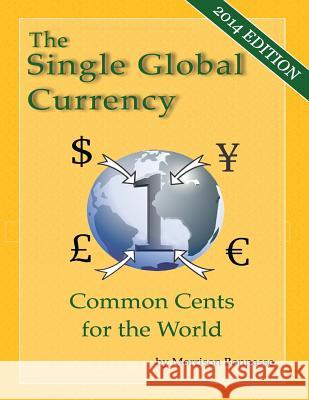The Single Global Currency: Common Cents for the World (2014 Edition) » książka
The Single Global Currency: Common Cents for the World (2014 Edition)
ISBN-13: 9780977842674 / Angielski / Miękka / 2014 / 286 str.
This 2014 Edition of THE SINGLE GLOBAL CURRENCY - COMMON CENTS FOR THE WORLD is the fifth book of this name, and it updates the text of the original 2006 edition. The 2007, 2008 and 2009 editions included the original edition together with an annual update appendix. Future editions are planned in five year increments for 2019 and 2024, the latter date being the 80th anniversary of the 1944 Bretton Woods Conference. The book is for all readers around the world, as every human being in our increasingly globalized world has an interest in achieving the goal of a Single Global Currency. What the people of the world want and deserve is stable money, so that the money they earn, save and invest today will be worth almost the same tomorrow. The Single Global Currency will provide that stability. It is the common cents/sense currency for our increasingly globalized world. The current multicurrency global monetary system is volatile and extremely risky as $5.3 trillion worth of currencies are traded every trading day on the global foreign exchange markets. Currencies crises are a continuing threat. Avoiding the effects and risks of currency fluctuations and rapid flows of cross-currency capital were the primary goals of the International Monetary Fund at its 1945 creation, and the Single Global Currency will solve both problems. The Single Global Currency will be managed by a Global Central Bank within a Global Monetary Union. Since 1999, the primary model for this "3-G" system has been the euro which is managed by the European Central Bank within the European Monetary Union. Beginning with 12 member countries, the eurozone now has 18 members and continues to grow toward its full potential of all the members of the growing European Union, which now number 28. Creation of a Single Global Currency is not a new idea or goal, but is now feasible thanks to automation and the increasing interdependence of the world's peoples. The potential benefits of a Single Global Currency are staggering: - Worldwide asset values will increase by about $10 trillion. - Worldwide GDP will increase by $trillions. - Global trade will increase by $trillions. - Annual FX trading transaction costs of $300 billion will be avoided. - Global currency/payments imbalances will be eliminated. - Currency crises will be eliminated. - Currency speculation will be eliminated. - The need for unproductive foreign exchange reserves will be eliminated. Currently, the 193 members of the United Nations use 140 currencies for their international and domestic transactions. The 50+ members without their own national currencies are using the currencies of monetary unions of which they are members, or they are using ("izing") the currencies of other countries or monetary unions. As existing monetary unions in Europe, the Caribbean and Africa are expanded, and as new monetary unions are created in Africa, the Americas, Asia and the Mid-East, the number of currencies will continue to decline. At some "tipping point," perhaps after a merger of large currencies, the largest monetary union currency will likely be designated as the world's Single Global Currency. This process can be accelerated when individuals, nations and global institutions openly declare their support for a Single Global Currency and they initiate the necessary steps toward that goal. Such steps will include a global internet-based naming process for the new currency and a timeline for implementation. There is little question that the world is moving toward a Single Global Currency. The remaining question is When? The global challenge will be to achieve the Single Global Currency with a smooth transition from the existing multicurrency system. It is hoped that this book, and the work of the Single Global Currency Association (www.singleglobalcurrency.org) will help move the world in that direction.











